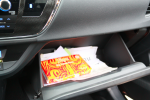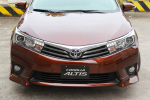The once-humble Corolla is the engine that built the mighty company. With more than 40 million units sold worldwide, the Corolla attained the status of world’s best-selling car by 1997. More than one out of every four Toyotas carries a Corolla badge. It may have lost its leadership position in some developed markets such as Japan, where the Prius has become more popular, or the United States, where they prefer the larger Camry. In the more economically challenged Philippines, the best seller title has shifted to a smaller car, the Vios. Still, the Corolla is a crucial part of Toyota’s lineup, its heart and perhaps its soul. So with the company’s new “Fun to Drive” imperative embodied in the Corolla, here’s some of what we experienced in our first 24 hours with the new sedan:
1. Newfangled style
What a difference a generation makes. The previous Corolla was styled like an econobox onto which luxury trimmings were slapped on-look at the side profile to see its humble origins. The 2014 car looks markedly different, with more character lines, complex surfaces and a more planted stance. Walk around it and you’ll notice the way that different panels catch the light and play with reflections. This definitely does not look like your father’s Corolla. Original Corolla chief engineer Tatsuo Hasegawa would no doubt be delighted with Toyota’s “world car.”
The car is longer by 99 millimeters, wider by 16 mm and lower by 10 mm. Despite the bigger footprint, the car looks compact thanks to the new design.
The 2.0V goes all-out for the sporty look. It gets an extensive aero kit, from a front bumper festooned with Formula One-style vanes, to a side skirt, to a tasteful lip spoiler on the trunklid. Under the rear bumper are faux carbon-fiber Venturi channels. They don’t look deep enough to provide any real aerodynamic effect and are verging on overstyling, but somehow fit with the rest of the kit.
2. LED headlamps

Corolla Altis 2.0V features dual LED illumination, plus LED daytime running lights. The main lights are floodlight-powerful.
Adding high-intensity discharge (xenon) headlamps at the factory is a good way to boost a car’s perceived value and enhance safety. The new Corolla goes a step further by being equipped with standard all-LED headlamps for the 2.0V, the first such application in a nonluxury car. LED headlamps light up faster and are more energy-efficient than halogen or xenon bulbs. Switching on the lights is akin to turning on huge floodlights.
There are also small eyebrows within the lamp clusters, using four small LEDs per side. These act as the daytime running lights. The rear also uses LED lighting. The taillamps themselves are attractively tapered and are expansive, making the car look wider. Lower variants will have to make do with halogen headlamps, but the taillights are also LEDs.
3. 17-inch wheels with Michelin Pilot Sport 3 tires
Once the realm of sports cars, large wheel-low profile tire combinations have been trickling down to the mass-market level. The Corolla matches the factory wheels of the sportier C-segment offerings with 17-inch aluminum alloy wheels on the 2.0V (16-inchers on the lower variants). Styling is a matter of taste, but to our eyes, the seven split-spokes look distinctive. Wrapped around them are 45-series Michelin Pilot Sport 3 tires. Michelin describes these as maximum-performance summer tires for sport-oriented vehicles and high-powered sedans. They’re original equipment on cars like the Mercedes E 63 AMG and Audi A5. With only 145 PS under the hood, this is a bit of overkill, but it’s always good to have a higher-performance tire than absolutely needed.
4. Keyless entry
The new Corolla, just as on the highest variant of the previous model, carries a genuinely useful keyless entry system. With the key in your pocket or plucked-ostrich satchel, the Corolla’s sensors will unlock the doors when you grasp the handle. There’s a power button to start the engine or turn on the electricals. The trunk, too, can be opened without having to press the key, although there’s a manual lever for those so-called security checks.
5. Seats, panels and gauges
An attractive exterior would only disappoint if the interior wasn’t up to snuff. Fortunately, the Corolla mostly delivers in this aspect as well. Gone is the awful, awful plastic wood from past models; likewise, any beige-colored seats that brighten the cabin but wear down notoriously easily. The new 2.0V is trimmed in black leather and soft-touch plastics, with matte chrome trim neatly integrated.
Toyota has also abandoned gaudy Christmas-tree-like colored displays for straightforward blue-background gauges. There’s a pair of large main indicators for tachometer and vehicle speed, with a red-and-white LED screen displaying warnings and trip computer information between them.
Rather than the vertical stacking instrument panel we were used to, the new Corolla goes for a horizontal layout, a la BMW. Only, this one features blue lighting rather than red and is much easier to decipher. The effect is to notch up the perceived quality. When taking some kids for a ride, one of them asked if we were in an Audi.
The seats provide better support than its predecessors’. The 2.0 features all-power adjustment, including seat height and lumbar support. This really helps in finding a comfortable driving position. We still found the beltline high after setting the seat to our preferred position, and the hood drops out of sight. In practice, it didn’t pose any problems in maneuvering. The front and rear bumpers are peppered with parking sensors: two in front and four in the rear.
The built-in audio system can connect via aux cable, USB or Bluetooth. Pairing was quick and painless, and the audio was clear and pleasant.
The Corolla’s wheelbase has been lengthened by 100 mm, benefiting rear-seat knee room. There’s enough for medium-height adults to avoid scraping their knees on the front seats. The rear seat bottom is still on the short side. Shoulder room is comfortable for two, with three not out of the question. The nearly-flat rear floor also helps.
There’s a manual rear sunshade, three-point seatbelts and Isofix child seat anchors. Trunk space is deep and wide, enough to swallow a couple of large suitcases.
6. New engine and transmission

2014 Corolla Altis 2.0V has 144hp and 187Nm, adequate for city and highway duties, even with a full load of passengers.
The engine start/stop button fires up the nearly silent four-cylinder engine. The 2.0-liter DOHC power plant features 16 valves, variable valve timing on both intake and exhaust sides (thus the Dual VVTi designation). The engine is equipped with the Acoustic Control Induction System, Toyota’s variable length intake manifold system. The system uses a valve to vary the length of the intake tract to feed the engine the optimum amount of air. This is supposed to lessen intake roar. In practice, the engine really is whisper quiet, even at higher revs.
The standard transmission for the E and G variants, with the new continuously variable transmission available on the G and standard on the V variants. The CVT hooks up instantly without the rubber-band effect of the first-generation CVTs. It is able to transmit torque efficiently. When climbing up steep parking lamps with a full load of passengers, it didn’t hesitate or stutter. The primary benefit of the CVT is to enhance fuel economy. For manual control of seven virtual gears, there’s a separate gate on the shifter and paddles mounted behind the steering wheel.
The 2-liter engine’s mileage hovered around 10 kilometers per liter in light-traffic city driving. With 144 HP and 187 Newton-meter, the engine provides sufficient acceleration for driving around town. The Corolla already weighs in at 1300 kilograms, and the 2-liter seems the best match for the heavier body.
7. Driving

The sporty exterior, all-business interior and sport tires had us expecting a little 86 magic in the drive. It’s not quite there, but the tighter handling and non-wallowy ride are steps in the right direction.
All those cues—the swoopy styling and aero bits, business-like interior and sports car-level tires—led us to believe that we were about to get a bit of that 86 handling. That may have been too much wishful thinking. Steering effort with the electric power assist is meatier than in any Corolla in recent memory.
With MacPherson struts up front and a torsion beam rear axle, the Corolla provides predictable but by no means entertaining handling. This is still a comfort-oriented sedan under the skin.
ABS brakes are standard across the line. The V models get four wheel discs while the rest make do with rear drums.
The ride is certainly firmer than before without going into harsh territory. Road irregularities are considerately filtered out, despite the 45-series sport tires. Only those irritating speed strips remain, well, irritating.
8. Pricing
The suggested retail prices for all variants creep up, by an average of 3.3 percent:
2.0V CVT P1.201 million
1.6V CVT P999,000
1.6G CVT P935,000
1.6G 6-speed M/T P879,000
1.6E 6-speed M/T P836,000
White pearl paint will be available on the V models and will cost an extra P15,000.
Colors for the V variant will be: white pearl, red mica metallic, dark brown mica metallic, dark gray and attitude black. For the G variant, colors will be: thermalyte, red mica metallic, dark brown mica metallic, dark gray and attitude black. The E variant will have a choice of: freedom white, thermalyte, red mica metallic and attitude black.
With the 2014 Corolla Altis, Toyota has pushed its venerable nameplate firmly into sportier territory, at least where the 2.0V is concerned. The exterior is distinctive and the interior rather classy. Assembly quality is top notch, with good fit and finish, and tight gaps between body panels. The driving experience is not quite there yet, with comfort-oriented steering and handling that shrugs rather than grins. If you want a soothing, quiet commute with plenty of newfound style, the 2014 Corolla Altis merits serious consideration.
- A SHARP nose melds well with the more shapely side panels in the 2014 Corolla Altis.
- Front end features a sculpted bumper and the V-shaped Toyota grille and lights combo
- Corolla Altis 2.0V features dual LED illumination, plus LED daytime running lights. The main lights are floodlight-powerful.
- With the key in your pocket, driver’s door can be locked and unlocked by touch
- Is this a Corolla, or an Audi? New interior is clean and elegant. We hope you like it in black.
- 2014 Corolla Altis 2.0V has 144hp and 187Nm, adequate for city and highway duties, even with a full load of passengers.
- The sporty exterior, all-business interior and sport tires had us expecting a little 86 magic in the drive. It’s not quite there, but the tighter handling and non-wallowy ride are steps in the right direction.
- 2014 Toyota Corolla Altis 2.0V has a full-size spare tire
- Aside from the manual-mode shift gate for the CVT, Corolla Altis 2.0V also has shift paddles mounted behind the steering wheel
- 2014 Toyota Corolla Altis 2.0V power driver’s seat has eight-way power adjustment, including lumbar support.
- 2014 Toyota Corolla Altis 2.0V features Michelin Pilot Sport 3 rubber. No expense spared here
Disclaimer: The comments uploaded on this site do not necessarily represent or reflect the views of management and owner of Cebudailynews. We reserve the right to exclude comments that we deem to be inconsistent with our editorial standards.










































